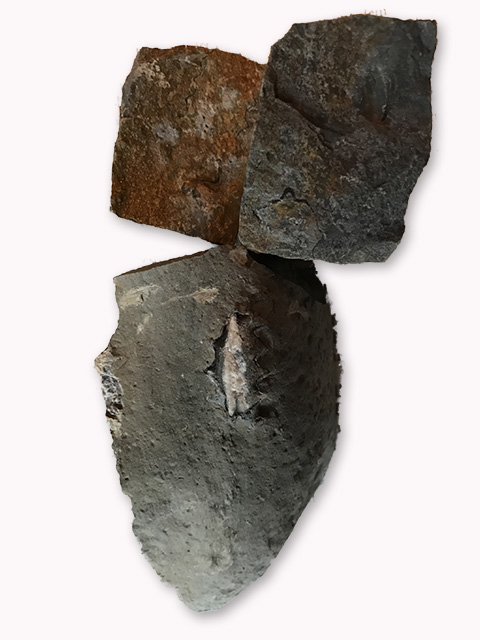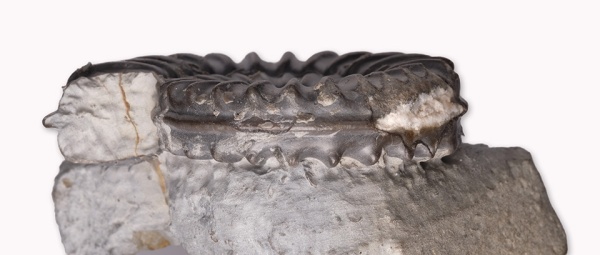have high hopes for them, but you take them home anyway.
This was very much the case for this specimen shown as found ex-situ in
Robin Hoods Bay this March. It just showed the section of an ammonite
on the side of the nodule, when formatting the rock, the part containing the
ammonite also fell into 3 pieces due to natural cracks.
I think there might have been a moment when I thought of chucking the
bits into the sea, but the breaks were clean and promised to be simple to
glue so it went into the bag…
I often accumulate a few specimen that have been previously roughly prepared
with a big pen, then fine prepped with a small pen and just need that little bit of
extra cleaning with the air abrader – preparations before and cleaning up after
air abrading take some time and I usually don’t do that for single specimen.
I had glued the parts of the small nodule back together again, and after finishing
my other specimen to be abraded, I had a bit of powder still in the tank and
decided just to test the ammonite to see what it was.
With nodules that have been weathering or a while that usually works, even if
the nodule itself is not completely abradeable due to increasing hardness of the
matrix when the weathered layer is off.
To my surprise, I could just keep on abrading…
The matrix was soft enough to be abraded at a relatively low pressure (3.5 bar),
the ammonite´s shell was beautifully preserved in dark grey calcite, and the
ammonite had a very strong undamaged keel.
I had initially wondered if it could be an Arnioceras, and that seemed to be the
correct genus identification.
ever becomes abradable.
The innermost whorls up to about 1 cm are relatively smooth just like in Arnioceras semicostatum,
but the ribbing is more straight and finishes almost abruptly at the edge of the venter.
starting the full text database on the computer)
section, style of ribbing and keel was a good match, the count of ribs/whorl of my
specimen was lower, and A. oppeli seems to not have smooth innermost whorls.
collection, which is Arnioceras bodleyi (J. BUCKMAN, 1844).
fame)).
in my specimen, and maybe less compressed than the Kilve specimen, and no keel
furrows.
nagging thought that you have when something does not completely fit…
As a final check I consulted with some friends from the facebook Yorkshire fossils
collectors group if they had seen a similar Arnioceras from a soft matrix –
and Dave showed me a perfectly matched specimen from Redcar, in a very soft matrix !
Now two occurrences of Arnioceras in soft matrix make a pattern, so I scanned
HOWARTH´s summary of Bairstow´s collection again for Arnioceras from
Robin Hoods Bay – and found mentions of Arnioceras above the semicostatum
subzone, in the turneri zone, birchi/brooki subzone !
Ammonites from these subzones in Robin Hoods Bay show exactly the same style of
preservation and “abradebility”, unfortunately HOWARTH does not figure them,
the brooki subzone Arnioceras from the Bairstow collection are mentioned as
“?Arnioceras sp. indet. 1,lost”, and I unfortunately don´t remember from my last visit
what the two specimen from the birchi subzone housed in the collection looked like.
So back to the database…what species of Arnioceras occurs above the semicostatum
subzone ?
Kevin Page´s paper “The lower Jurassic of Europe: its subdivision and correlation”
delivers a hint on Arnioceras hartmanni from the brooki subzone, but no figure…
No luck in the Palaeontological Association´s “Fossils from the Lower Lias of the
Dorset Coast” either – “not figured“.
and it´s a perfect match and he also mentions that it can be found in the Whitby area !!!
“Ammonites hartmanni” by OPPEL which I found after a bit of internet research in the
Paris Muséum National D’Histoire Naturelle’s online collection (very nice !)
It is still somewhat “circumstancial evidence”, since the ammonite was found ex-situ,
and of course therefore I cannot with absolute certainty know that this ammonite
really is from the brooki subzone but I think it´s close enough to give it a name,
at least with a “cf.” :
Arnioceras cf. hartmanni (OPPEL)
So if anyone has a Caenisites brooki together with an Arnioceras from Robin Hoods Bay,
please let me know, for final proof 🙂
Anyway, who would have thought that you can spend this much fun time on a rainy
weekend prepping and digging through palaeontological history on this (only seemingly)
unremarkable little ammonite ?
The excitement of the fossil hunt becomes the hunt for a name, which to me can be
almost as exciting.
Literature and Links :
Gustav Fischer Verlag
Leslie Bairstow, Bulletin of The Natural History Museum Geology Series Vol. 58/2, London
Jahreshefte des Vereins für vaterländische Naturkunde in Württemberg
Geological Survey of Denmark and Greenland Bulletin 1





